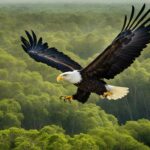Have you ever gazed upon a bald eagle and found yourself transfixed by their fierce, almost angry expression? You’re not alone! This powerful bird of prey is known for its intense look, which seems to exude a sense of determination and strength. But have you ever wondered why they appear so angry? In this article, we’ll explore the mystery behind the bald eagle’s angry appearance and shed light on the factors that contribute to their fierce look.
Key Takeaways:
- The bald eagle’s angry appearance has become synonymous with their national representation and values.
- Evolutionary factors may have contributed to the development of the bald eagle’s intense facial expressions.
- Behavioral observations suggest that the bald eagle’s natural behaviors may be influencing their angry appearance.
- Despite their fierce appearance, bald eagles possess unique beauty and inspiring presence in nature.
The Facial Expression of Bald Eagles
Have you ever been mesmerized by the intense look on a bald eagle’s face? From their piercing eyes to their hooked beaks, everything seems to suggest a fierce and angry demeanor. But why do bald eagles look so angry?
The facial expression of bald eagles is uniquely suited to their predatory lifestyle. Their sharp, downward-curved beak and strong, curved talons are meant to capture and kill prey. Their intense gaze and fierce expression help them to intimidate other animals and convey a sense of dominance and power.
The Facial Features that Contribute to the Angry Appearance of Bald Eagles
One of the most striking features of a bald eagle’s face is their pronounced brow ridge. This ridge, along with the slightly downturned corners of their beak, gives them a perpetually stern, even aggressive, expression. Their eyes are also set deep in their skull, which further accentuates their intense gaze and gives them an almost human-like quality.
Another factor that contributes to the angry appearance of bald eagles is the coloring around their eyes. The dark feathers that surround their eyes resemble a mask, which serves to make their gaze even more intense.
So, while bald eagles may not actually be angry, their facial features suggest otherwise. Their fierce and intimidating expression is perfectly suited to their role as apex predators, allowing them to thrive in their natural habitat.
The Symbolism Behind the Angry Look
Have you ever wondered why the bald eagle, as the national bird of the United States, has such an intimidating appearance? The truth is, the angry expression on their face symbolizes the strength, power, and resilience of this magnificent bird.
The bald eagle is a proud and noble creature that represents freedom, courage, and independence. Its fierce and intense gaze communicates a sense of strength and determination, making it the perfect symbol for a country built on these same values. The bird’s sharp eyesight, powerful wings, and sharp talons are also symbolic of its ability to protect and defend the land it calls home.
The angry expression of the bald eagle is not a sign of aggression, but rather a reflection of the bird’s resiliency. Like the United States, the bald eagle has faced challenges and obstacles throughout its history, but it has always been able to rise above them.
The symbolism behind the bald eagle’s appearance is so powerful that it has become synonymous with the country itself. The bird’s fierce image can be seen on the Great Seal of the United States, the Presidential Seal, and the flag of the President of the United States.
So, the next time you see a bald eagle with an angry expression on its face, remember the important symbolism behind its appearance. It is a powerful reminder of the strength, resilience, and determination that has made the United States the great country that it is today.
Evolutionary Factors Influencing Facial Expression
The intense and fierce expression on the face of a bald eagle is not just for show; it may have developed over time due to evolutionary factors. The adaptive advantage of this angry appearance could be twofold:
- It may be a means of deterring potential predators or competitors. The aggressive and intimidating look of a bald eagle could warn off other animals and prevent them from encroaching on its territory or challenging its position.
- It may also aid in hunting and catching prey. The intense and focused expression may help the eagle to spot and track its targets more effectively, giving it an advantage when in pursuit of food.
These evolutionary advantages are not unique to bald eagles, as other predators such as lions and tigers also have a fierce appearance that serves a similar purpose. However, the specific facial features and expressions of bald eagles may have developed through their natural selection process, adapting to their specific environment and prey.
While the angry appearance of bald eagles may seem intimidating to humans, it is a necessary adaptation for their survival in the wild. Understanding the evolutionary factors that contribute to this expression can help us appreciate the complex nature of these majestic creatures.
Behavioral Observations of Bald Eagles
When observing bald eagles in their natural habitat, it becomes clear that their angry appearance is not just for show. Researchers have noted various emotional cues that suggest these birds of prey are not to be trifled with.
One notable behavior is their tendency to puff out their feathers and flap their wings aggressively when threatened or defending their territory. This display serves as a warning to potential predators or other eagles that they are not afraid to protect what is theirs.
Bald eagles also exhibit a high level of focus and intensity when hunting or scanning their surroundings. Their eyes become fixed and unblinking, showcasing their sharp vision and unwavering determination.
Interestingly, researchers have also observed instances of bald eagles showing affection and tenderness towards their mates and young. This suggests that underneath their fierce exterior lies a complex range of emotions and behaviors.
Overall, the behavioral observations of bald eagles provide valuable insights into the reasons behind their angry appearance. Their aggressive postures and gestures serve a clear purpose in their survival and reproduction, demonstrating the adaptability and resilience of these magnificent birds.
The Role of Body Language in Bald Eagles’ Angry Appearance
While the facial expression of a bald eagle can certainly give the impression of anger, it is important to also consider the influence of body language. Bald eagles are known for their aggressive posture and intimidating gestures.
One key behavior to look out for is their territorial displays. When protecting their nest or claiming a fishing spot, bald eagles will often puff up their feathers, extend their wings, and make vocalizations to ward off any potential threats. This display can give the appearance of anger, but is actually a defensive mechanism.
Another factor to consider is the way bald eagles hunt. These birds of prey are incredibly skilled and will often use their powerful talons to take down prey. Their body language during a hunt is focused, intense, and determined, further contributing to their fierce image.
Even when perched or in flight, bald eagles maintain a dignified posture that exudes confidence and power. Their size alone is impressive, but their regal bearing adds to their intimidating presence.
In short, the angry appearance of bald eagles is not just a result of their facial expression, but also their body language. Their aggressive postures and territorial displays are natural behaviors that contribute to their overall image of strength and power.
As you observe these magnificent birds in the wild, take note of their body language and behaviors. By understanding the context behind their actions, you can gain a deeper appreciation for their impressive presence.Myths and Misconceptions
When it comes to the angry appearance of bald eagles, there are several myths and misconceptions that have been perpetuated over time. Let’s take a closer look at some of these:
Myth: Bald Eagles are Always Angry
While it’s true that bald eagles can appear angry, this is not their default mood. Like any other animal, bald eagles can display a range of emotions, including happiness, contentment, and even playfulness.
Misconception: Bald Eagles Attack Humans
While bald eagles are large and powerful birds, they are not known to attack humans unprovoked. In fact, bald eagles prefer to avoid human contact and will often fly away if they feel threatened or cornered.
Myth: The Angry Look is Meant to Intimidate
Contrary to popular belief, the angry look of bald eagles is not meant to intimidate. In fact, this intense facial expression serves a practical purpose in the bird’s natural environment. It allows them to focus on their prey and protect themselves from potential threats.
Misconception: Bald Eagles are Vicious Predators
While bald eagles are skilled hunters, they are not inherently vicious or bloodthirsty. Like any other predator, they hunt to survive and provide for their young. In many cases, bald eagles will scavenge for food rather than hunt live prey.
By dispelling these myths and misconceptions, we can gain a better understanding and appreciation for the true nature of these magnificent birds. Despite their intense appearance, bald eagles are a vital part of our ecosystem and deserve our respect and admiration.
The Role of Body Language in Angry Appearance
It’s not just the intense expression of bald eagles that contribute to their angry appearance, but also their body language. These majestic birds have a unique way of carrying themselves that further enhances their fierce image.
The aggressive posture of bald eagles is a sight to behold. They stand tall and proud, with their wings often spread wide. Their sharp talons are prominently displayed, ready to strike at any moment. Their overall body language exudes power and strength.
Bald eagles also use their body language to communicate with each other. When they feel threatened or challenged, they will puff up their chest and raise their head, making themselves appear larger and more intimidating. On the other hand, when they are relaxed and content, they will lower their head and tuck their wings neatly against their body.
So, the next time you observe a bald eagle, take note of their commanding body language. It’s just one more reason to appreciate the stunning presence of these remarkable birds.
Conclusion
Now that you’ve learned about the mysterious appearance of bald eagles, you may have a deeper appreciation for these magnificent creatures. While their angry expression may be intimidating, it’s important to understand the symbolism and evolutionary factors that have shaped this characteristic.
By observing their body language and natural behaviors, we can gain a better understanding of the emotions behind their fierce appearance. It’s also important to separate fact from fiction and dispel any myths or misconceptions surrounding bald eagles.
Despite their fearsome appearance, bald eagles are truly beautiful creatures with unique features and an awe-inspiring presence in nature. So, the next time you see a bald eagle, take a moment to appreciate their majesty and the intricate complexities that make them such incredible animals.
Is the Angry Appearance of Bald Eagles Related to their Sleeping Habits?
Bald eagles, known for their fierce and majestic appearance, often evoke curiosity about their daily routines. Many wonder where do bald eagles sleep, and if their angry demeanor is somehow connected to their sleeping habits. While the sleeping patterns of these iconic birds vary, bald eagles typically choose high and secluded areas, such as tall trees or cliffs, to rest and sleep. Despite their fierce visage, their sleeping habits might not necessarily contribute to their angry appearance.
FAQ
Q: Why do bald eagles look angry?
A: The angry appearance of bald eagles is often a result of their unique facial features, which include intense eyes and a fierce expression. This facial expression is believed to be an evolutionary adaptation and is not indicative of their actual emotions.
Q: Are bald eagles actually angry?
A: No, the angry appearance of bald eagles is a result of their facial features, not their actual emotions. They may exhibit a range of emotions like any other living creature, but their facial expression does not necessarily reflect their inner state.
Q: What is the significance of bald eagles looking angry?
A: The angry look of bald eagles has become a symbol of power, strength, and majesty. It is often associated with their status as the national bird of the United States and represents the values of freedom and independence.
Q: Do all bald eagles look angry?
A: Not all bald eagles have the same angry expression. Some individuals may have a milder or less intense appearance, while others may exhibit a more pronounced angry look. It varies among individuals and can also change depending on their behavior and surroundings.
Q: Is the angry look of bald eagles intimidating to other animals?
A: Yes, the angry appearance of bald eagles can be intimidating to other animals. Their fierce expression and aggressive postures often serve as a deterrent to potential threats and help them establish dominance in their territory.
Q: Are there any other factors that contribute to the angry look of bald eagles?
A: In addition to their facial features, the body language exhibited by bald eagles also contributes to their angry appearance. Their aggressive postures and gestures further enhance the perception of their fierce nature.
Q: Are there any myths or misconceptions about bald eagles’ angry look?
A: Yes, there are some myths and misconceptions surrounding the angry look of bald eagles. It is important to understand that their facial expression is not indicative of their emotions, and they are not constantly angry or aggressive. It is a natural part of their appearance and should not be misunderstood.
Q: Can we appreciate the beauty of bald eagles despite their angry look?
A: Absolutely! While the angry look of bald eagles may initially capture attention, it is essential to appreciate the overall beauty of these majestic birds. Their impressive wingspan, regal presence, and graceful flight are all aspects that make them truly awe-inspiring.










